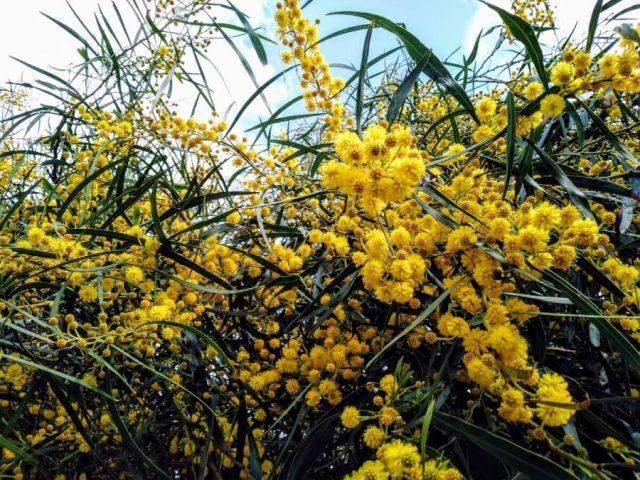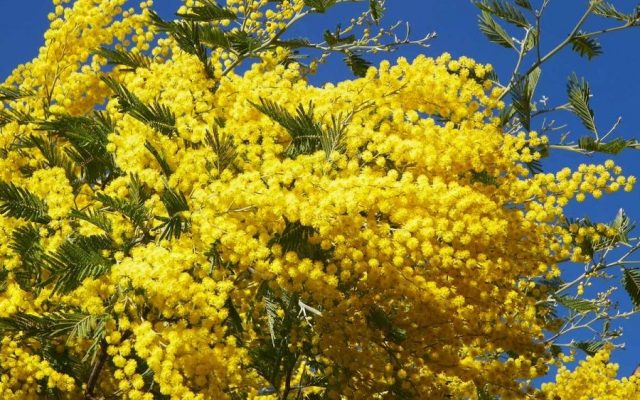Content
There are many varieties of acacia. Shrubs and trees differ from each other in size and flowering characteristics, as well as requirements for growing conditions.
Acacia: photo and description of the tree
Acacia (Acacia) is a flowering plant of the Legume family. It is a medium-sized shrub or tree up to 25 m tall with a trunk girth of up to 1.2 m. It has a powerful root system with a main stem and numerous superficial shoots. The bark is smooth and green when young, later gray or brown, covered with cracks.
The leaves of the plant are pair-pinnate or double-pinnate, compound, arranged on the branches in an alternate or whorled pattern. In many varieties, instead of plates, the shoots are covered with needle-like or lanceolate phyllodes. Flowering most often occurs in late May or early June; the plant's buds are small, collected in racemes, panicles or capitate inflorescences. They have 3-5 petals of white, yellow, orange or cream color.The fruits are elongated beans with spherical or elongated flattened black or light brown seeds.
In its natural form, the plant is widely distributed in tropical and subtropical regions. Found in Australia, Mexico, Africa and Asia, India and Madagascar. Artificial shrubs are grown all over the world. Most often, the crop is grown indoors, since it does not tolerate harsh climates well.

Acacia bushes begin to bloom in the second season after planting and then bloom annually.
Types of acacia with photos and names
Acacia can be very different - tall and miniature, with early and late flowering. To get a good understanding of the shrub, you need to study the popular species.
Curved
Curved Acacia (Acacia adunca) is a shrub native to Australia. It has straight branches directed upward at an acute angle and elongated pinnate leaves. It bears raceme inflorescences consisting of several spherical heads of a light yellow hue. The variety's pods are narrow, up to 7 cm in length.

Curved acacia in nature reaches 6 m above the ground
Gorgeous
Magnificent acacia (Acacia spectabilis) is a medium-sized variety up to 4 m above the ground. The leaves are pinnate, the flowers are collected in bright yellow heads. The variety blooms mainly from July to November. After flowering, it bears fruit-pods up to 17 cm long.

Magnificent acacia is widespread in North America and Australia.
Willow
Among the types of acacia with photos and names in Russia, the willow (Acacia saligna) deserves attention - a small tree or shrub up to 5 m tall.It has spreading outlines and bears numerous rich yellow flowers. It grows naturally in Africa, Australia and the Middle East, as well as in South America.

Acacia willow variety is often used to prevent soil erosion and restore vegetation cover
Mixed
Mixed acacia (Acacia confusa) is a tall tree, reaching 15 m above the ground. The species is common in Hawaii and other tropical areas of the Pacific Ocean. It has very dense wood; the plant is used in construction and for making coal.

Mixed acacia has medicinal properties and is used in folk medicine
Longifolia
Long-leaved acacia (Acacia longifolia) is a tall tree up to 7 m above the ground surface. The plant is native to Australia and can also be found in some US states. It blooms with bright light yellow panicles and blooms in late spring and early summer. The variety is also used for food purposes - the buds and beans are edible.

The long-leaved acacia variety grows to its maximum in an average of 5-6 years
Myrtifolia
Acacia myrtifolia is a relatively low shrub. It blooms in winter and spring and is found naturally in Australia. It blooms with numerous buds of a light yellow or cream color.

The height of the myrtle-leaved acacia variety is about 3 m
Double-edged
Double-edged or edged acacia (Acacia anceps) is a low shrub with wide-spreading branches. It has ovate, narrowed leaves, and bears rich yellow, axillary flowers.The buds are arranged singly on long stalks.

Double-edged acacia can reach 3 m above the ground
Silver
Silver acacia (Acacia dealbata) is a tall tree up to 10 m above the ground surface. It has straight branches with whitish smooth bark, leaf blades are double pinnate, ash-colored. During the flowering period it bears small spherical buds up to 8 mm in diameter. Distributed in India, China, Australia and West Africa.

During the flowering period, the silver acacia variety exudes a pleasant aroma
Leafless
Leafless acacia (Acacia aphylla) is a shrub up to 2.5 m in height. In accordance with the name, it does not have leaf blades, but it blooms with numerous golden round flowers. In its natural form, the acacia variety grows in the tropics on rocky soils. From December to March the bush bears abundant fruit.

The leafless variety blooms late - in August and early September.
Veinless
The flowering acacia species (Acacia aneura) has medium dimensions and stretches up to 2-7 m. It is an endemic plant, found in its natural environment only in Australia. Used as livestock feed.

Veinless acacia tolerates severe drought well and is suitable for growing on the poorest soils.
Armed
Armed acacia (Acacia armata) is an ornamental shrub with gnarled branches covered with thorns. Spreads widely to the sides during development. In spring it blooms with bright yellow abundant inflorescences.

Armed acacia grows up to 3 m above the ground
Raznokolyuchkovaya
Acacia ataxacantha is a popular shrub with climbing shoots among gardeners.The branches are covered with large curved thorns up to 1 cm long, resembling claws in appearance. With the help of spines, the plant clings to the support and rises up. The leaves are bipinnate, up to 15 cm in length, the inflorescences are spike-shaped white.

The length of the inflorescences of the multi-thorned acacia variety reaches 8 cm
Barbed
Prickly acacia (Acacia tetragonophylla) is an Australian plant up to 4 m above the ground. Instead of leaves, the branches have phyllodes up to 3 cm in length; at a young age they are soft and flexible, then they turn into thorns. Photos and descriptions of the acacia shrub show that the flowers of the variety are yellow, collected in spherical heads.

The prickly acacia variety is also known as curare
Ashby
Ashby acacia (Acacia ashbyae) is a shrub up to 2 m long, blooming with small yellow flowers in short racemes. The leaves of the plant are oblong, dense, up to 9 cm in length, very narrow with a solid edge. Immediately after appearance, the plates are cream or with whitish pubescence, then become light green.

The Ashby variety can grow up to 2 m in diameter
Bailey
Bailey's acacia (Acacia baileyana) is an Australian medium-sized tree with miniature narrow leaves. The plates are pale green with a silvery coating, double pinnate, individual segments reach up to 6 mm in length. The flowers of the variety are pale yellow, collected in clusters of ten pieces. During the decorative period, the shrub emits a light, pleasant aroma.

The Acacia variety Bailey blooms in March and April.
Double-core
Two-vein acacia (Acacia binervata) is a shrub or tall tree capable of reaching 15 m. The shoots are covered with lanceolate or elliptical oblong leaves, the plates are quite wide - up to 2.5 cm.The inflorescences of the plant are cream-colored, collected in lush baskets of 20 pieces. An unusual feature of the species is the structure of the leaves - on the surface there is a pattern of two elongated veins.

Acacia bushes with two-vein leaves rise up to 5 m above the ground
Boxwood
Boxleaf acacia (Acacia buxifolia) is a medium-height shrub. During the flowering period it bears spherical buds with a rich dark yellow tint. Found in North America and Australia. During the fruiting period, straight or curved pods up to 7 cm in length ripen on the shoots.

Boxwood acacia bushes prefer to settle in wooded areas
Short-spike
Short-spiked acacia (Acacia brachystachya) is a dense shrub up to 5 m tall with spreading thick branches. The shoots are covered with narrow green leaves with a bluish tint, the length of the plate reaches 14 cm. During the decorative period, the crop bears small yellow buds, united in cylindrical brushes up to 2 cm. The fruits of the plant are pods up to 8 cm in length.

The natural habitat of the short-spiked acacia variety is Australia and Africa
Calamusolifolia
Acacia calamifolia is a shrub with a spherical crown. It grows on average up to 4 m, sometimes reaching 10 m above the ground. The leaves of the plant are small, elongated, narrowly linear or cylindrical in shape with pointed tips. The plates are usually green with a grayish coating. The flowers of the variety are bright yellow, collected in racemes at the ends of the branches.The beans are oblong and wrinkled, reaching 14 cm.

Each inflorescence of calamus-leaved acacia can contain up to 50 buds
Bristly haired
Bristle-haired acacia (Robinia hispida) is a shrub from the Legume family up to 3 m in height. It has smooth shoots of olive-brown or reddish-brown color, covered with long reddish hairs. In fact, it belongs to the genus Robinia; from a botanical point of view, it has no relation to the acacias, although there are certain similarities between the cultures. It has round-oblong green leaves, bluish at the bottom. The flowers are pink or reddish, collected in loose clusters, odorless.

Bristle-haired Robinia blooms in May and June.
What species are acacias confused with?
Varieties of acacia in Russia are often confused with other plants. Most often, they also belong to the Legume family, but come from other genera.
In particular, acacias do not include:
- false acacia black locust (Robinia pseudoacacia) is a large tree up to 25 m tall with an openwork spreading crown and white or cream flowers, blooming in June and July;
False locust is often called white locust.
- tree caragana (Caragana arborescens) - deciduous shrub up to 7 m tall with large yellow buds appearing in early summer;
Tree caragana is known as yellow acacia, often found in the Caucasus, the Urals and Siberia
- ammodendron (Ammodendron) is a tree up to 8 m above the ground, common in Asian countries, with small dark purple flowers that usually bloom in April.
Ammodendron is also known as sand acacia
False acacias can be distinguished primarily by their leaves - they are usually wider and bear little resemblance to thorns. Most often, true varieties have low frost resistance and are therefore rarely found in temperate climates in the natural environment. False acacias are unpretentious and easily tolerate cold; they are widely used to decorate parks and squares.
Conclusion
Varieties of acacia deserve detailed consideration. The heat-loving plant is represented by a large number of varieties that have certain similarities, but also have important differences. The main disadvantage of the culture is its heat-loving nature - in cold climates the shrub is grown mainly in greenhouses.












They wrote to me about the tricolor acacia. I didn’t find it in your very interesting selection. Maybe I didn't notice?